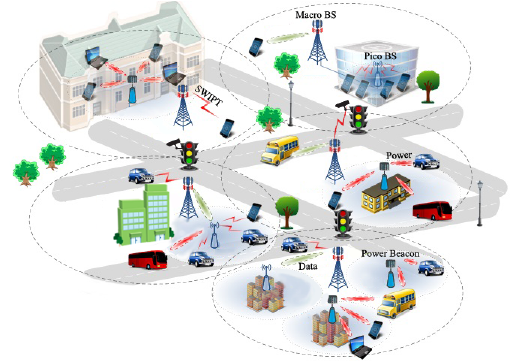A rapid growth of the volume of low-power wireless communication terminals is anticipated in the foreseeable future. This trend is attributed to the emergence of the 5G and Internet-of-Things (IoT)/Machine-to-Machine (M2M) communication paradigms. The considered energy-constrained devices are often installed at hard-to-reach locations or they correspond to mobile nodes. Smartphones, wireless sensors, and IoT nodes constitute representative examples of user equipment (UE) devices with limited energy storage capacity.
The explosive number, inaccessibility, and mobility of such UEs render the frequent wired recharging or replacement of their batteries a challenging and costly task. Wireless power transfer (WPT) represents a paradigm that addresses this issue via wireless replenish of the UEs’ energy through the transmission of radio frequency (RF) signals. WPT through radio waves achieves long ranges, as opposed to corresponding techniques based on electric or magnetic coupling. Furthermore, the use of dedicated RF energy sources provides stable and controllable wireless power supply, thus allowing for quality-of-service (QoS) provisioning. This is in contrast to energy harvesting (EH) based on renewable energy sources such as solar and wind or on ambient RF signals. In addition, WPT inherently supports one-to-many wireless charging and user mobility. These attributes make WPT a promising energy solution for the highly dense heterogeneous network setups envisioned in 5G and beyond (B5G), thus paving the way for the next-generation energy-autonomous wireless communication systems.
The integration of RF-WPT technology into communication networks introduces a fundamental co-existence of information and energy flows, wherein RF signals are used in order to convey information and/or energy. The efficient management of these two flows through sophisticated networking protocols, signal processing and communication techniques, and network architectures gives rise to a new communication paradigm called wireless powered communications (WPC).
APOLLO targets the emerging frontier research field of WPC technology. The realization of the WPC vision is a demanding endeavour that requires the establishment of the fundamental performance limits and trade-offs; the development of novel physical layer (PHY) and resource allocation techniques, including concepts like waveform design, precoding design, and information/energy transfer scheduling, or/and the adaption of the relevant state-of-the-art (SoTA) schemes; the design of new network architectures and communication protocols or/and the adaptation of existing ones; the design of innovative receiver architectures; the evaluation of the derived WPC methods both analytically and via link-level and system-level numerical simulations; the design, implementation, and testing of relevant prototypes; their integration into testbeds; and the conduction of proof-of-concept (PoC) experimental demonstrations in realistic environments.
APOLLO considers all the aspects mentioned above, but it deviates from the vast majority of relevant studies in that it focuses mainly on multi-cell, multi-user systems with multi-antenna nodes as well as on the integration of WPC with novel relevant technologies for M2M communications and 5G/B5G systems, such as small cells and ultra-dense networks, massive multiple-input multiple-output (MIMO) and cell-free massive MIMO, and millimetre-wave (mmWave). The increased degrees-of-freedom (DoF) and advanced features of these setups and technologies can benefit both information and energy transmission and significantly affect all the considered areas of research on WPC.
By bringing together a team of experts on complementary disciplines such as information theory, signal processing, stochastic geometry, probability theory, optimization theory, antenna design, and electronics/microwave engineering, APOLLO aspires to achieve a holistic study of all WPC aspects under the aforementioned context and, eventually, to: 1) push the boundaries of WPC well beyond what is currently possible; 2) shed light on the performance, design, testing, and development of contemporary and future WPC systems; and 3) facilitate the transition of this radically new approach in wireless communications from its conceptual phase to practical implementation.





